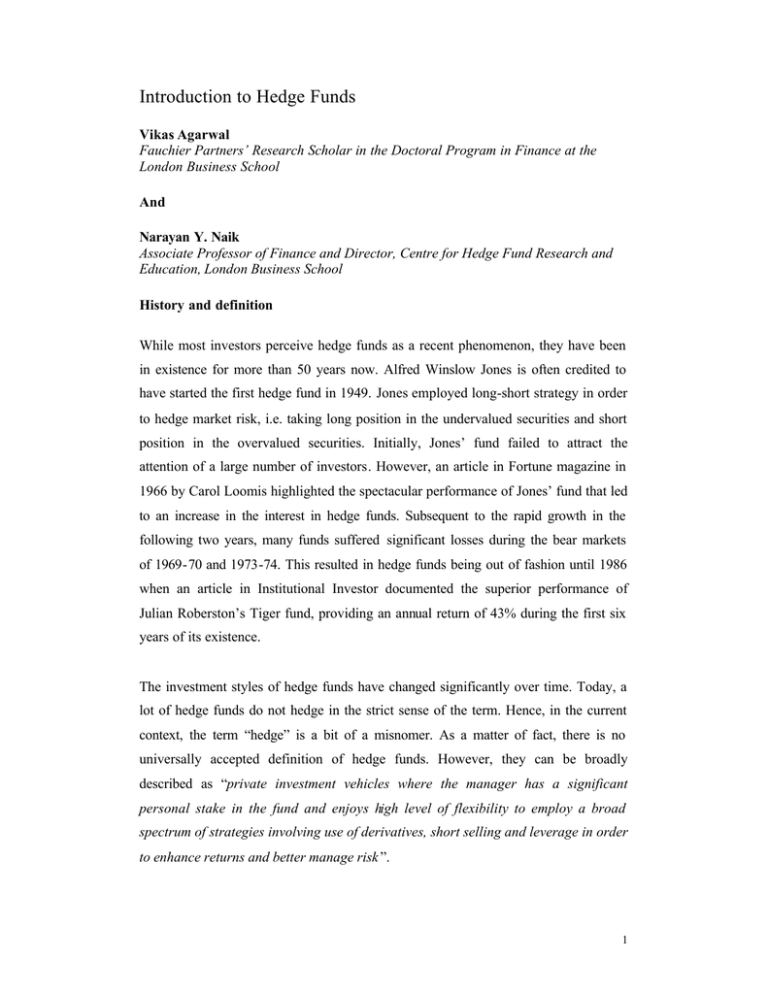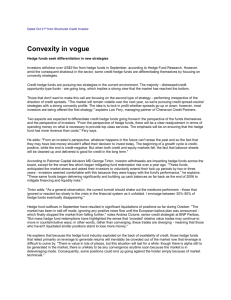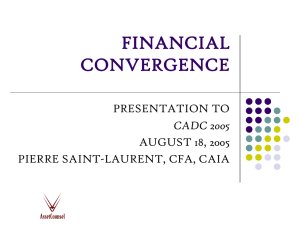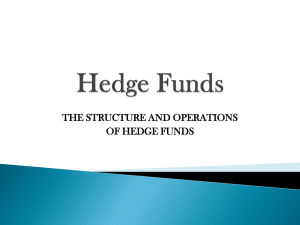Introduction to Hedge Funds
advertisement

Introduction to Hedge Funds Vikas Agarwal Fauchier Partners’ Research Scholar in the Doctoral Program in Finance at the London Business School And Narayan Y. Naik Associate Professor of Finance and Director, Centre for Hedge Fund Research and Education, London Business School History and definition While most investors perceive hedge funds as a recent phenomenon, they have been in existence for more than 50 years now. Alfred Winslow Jones is often credited to have started the first hedge fund in 1949. Jones employed long-short strategy in order to hedge market risk, i.e. taking long position in the undervalued securities and short position in the overvalued securities. Initially, Jones’ fund failed to attract the attention of a large number of investors. However, an article in Fortune magazine in 1966 by Carol Loomis highlighted the spectacular performance of Jones’ fund that led to an increase in the interest in hedge funds. Subsequent to the rapid growth in the following two years, many funds suffered significant losses during the bear markets of 1969-70 and 1973-74. This resulted in hedge funds being out of fashion until 1986 when an article in Institutional Investor documented the superior performance of Julian Roberston’s Tiger fund, providing an annual return of 43% during the first six years of its existence. The investment styles of hedge funds have changed significantly over time. Today, a lot of hedge funds do not hedge in the strict sense of the term. Hence, in the current context, the term “hedge” is a bit of a misnomer. As a matter of fact, there is no universally accepted definition of hedge funds. However, they can be broadly described as “private investment vehicles where the manager has a significant personal stake in the fund and enjoys high level of flexibility to employ a broad spectrum of strategies involving use of derivatives, short selling and leverage in order to enhance returns and better manage risk ”. 1 Industry Size and Growth Estimation of the size of the hedge fund industry is difficult due to the restrictions imposed by the Securities and Exchange Commission (SEC) on the advertising and reporting of performance by hedge funds. Van Hedge Fund Advisors International, a hedge fund advisory firm based in Nashville (US) estimates the number of hedge funds (excluding fund of funds) has increased from around 1,400 in 1988 to over 5,500 funds (both domestic and offshore) at the end of 1997. The volume of assets managed by them have also experienced a breathtaking growth during the same period, increasing by sevenfold from US$ 42 billion in 1988 to around US$ 300 billion. Another hedge fund advisory firm, Hedge Fund Research, estimates that the assets under management have grown from US$ 39 billion in 1990 to US$ 487 billion in 2000. Fur ther, it is important to keep in mind that this amount only represents the capital account balances of investors and not the actual amount of dollars deployed in the markets. With certain strategies investing on a highly levered basis, some believe that the total amount of dollars invested in the hedge fund arena now surpasses $1 trillion. A large majority of hedge funds are either based in the US or in an offshore territory. However, there has been a rapid growth in the number of hedge funds and the amount invested in them in Europe in the last few years. A recent survey of investors and hedge fund managers by Goldman Sachs projects a growth rate of 60% this year taking the total assets under management to US$ 73 billion. High net worth individuals form the largest group of investors in hedge funds. A study by RR Capital Management Corp. and KPMG Peat Marwick LLP in 1998 documents that 80% of the assets under management come from the private investors while the balance 20% is contributed by institutional in vestors including endowments, foundations, pension funds and insurance companies. The study analyses the recent trends in the hedge fund industry and projects an annual growth rate of about 26% to over $500 billion of assets by 2001 and a ten-fold increase to over $1.7 trillion in ten years. Classification of hedge funds 2 Although the term ‘hedge fund’ originated from the long and short strategy employed by the managers, the new definition of hedge funds covers a multitude of different strategies. Unlike the traditional investment arena, there does not exist a universally accepted norm to classify hedge funds. They can be classified either on the basis of domicile or the nature of the trading strategies employed by them. Based on domicile, hedge funds can be classified in two broad categories: onshore and offshore. Onshore funds are domiciled in the US and are usually in the Limited Partnership form, where the manager is the general partner and the investors are limited partners. Because hedge funds are private investment partnerships, prior to 1996, the SEC limited them to 99 investors, at least 65 of which must be “accredited”. In order to encourage investment in hedge funds, in 1996, the National Securities Markets Improvement Act modified the Investment Company Act and the SEC allowed these funds to exceed the previous limit of 100 investors to 500 (including the General Partner) without any registration and disclosure requirements. Recently, SEC have further broadened the ability of hedge funds to attract individual and institutional money by removing this limit altogether for “qualified investors”. For being considered as qualified investor, the individual investor's net worth must not be less than $5 million and the institutional investors such as pension funds should have a capital of at least $25 million. In contrast, offshore funds are established in tax neutral jurisdictions such as the British Virgin Islands, the Bahamas, Bermuda, the Cayman Islands, Dublin and Luxembourg allowing the investors to minimise their tax liabilities by investing outside their country. These investors are generally non-U.S. or U.S. tax-exempt investors. One of the more innovative offshore fund structures that allows for combining the offshore and onshore investors in the same investment vehicle is a Passive Foreign Investment Company. In this case, the offshore fund can accept both offshore and onshore investors but needs to always maintain at least a majority (50 percent) of offshore investors’ assets in the fund. Such a unique structure allows the manager to manage a single portfolio and not be concerned about allocating trades among offshore and onshore accounts to effectively serve both domestic and foreign investors. 3 On the basis of nature of trading strategies followed by hedge funds, they can be segregated into two broad categories: Non-Directional and Directional. Nondirectional strategies do not depend on the direction of any specific market movement and are commonly referred to as ‘market neutral’ strategies. It is important to note that the non-directional strategies are neutral only to the first moment, i.e. expected returns. They are not neutral to the second moment, as in volatile periods, liquidity dries up and convergence is not always obtained and such ‘arbitrage-based’ strategies can make losses. These are usually designed to exploit short-term market inefficiencies and pricing discrepancies between related securities while hedging out as much of the market exposure as possible. Due to the reduced liquidity inherent in many such situations, they frequently run smaller pools of capital than their counterparts following directional strategies. In contrast, directional strategies take directional bets and hope to benefit from broad market movements. These two main categories can be further divided into several popular sub-categories. Different database providers classify them somewhat differently. One of such classifications provided by Hedge Fund Research is shown for illustration in Table 1. It is important to note that this list is not the exhaustive list of hedge fund categories provided by different databases. 4 Table 1 Classification of hedge funds Non-Directional Strategies Fixed Income A strategy having long and short bond positions via cash or derivatives markets in government, corporate and/or asset-backed securities. The Arbitrage risk of these strategies varies depending on duration, credit exposure and the degree of leverage employed. Event Driven A strategy which hopes to benefit from mispricing arising in different events such as merger arbitrage, restructurings etc. Manager takes a position in an undervalued security that is anticipated to rise in value because of events such as mergers, reorganizations, or takeovers. The main risk in such strategies is non-realization of the event. Equity Hedge A strategy of investing in equity or equity-like instruments where the net exposure (gross long minus gross short) is generally low. The manager may invest globally, or have a more defined geographic, industry or capitalization focus. The risk primarily pertains to the specific risk of the long and short positions. Distressed Securities A strategy of buying and occasionally shorting securities of companies under Chapter 11 and/or ones which are undergoing some form of reorganization. The securities range from senior secured debt to common stock. The liquidation of financially distressed company is the main source of risk in these strategies. Merger Arbitrage A strategy of purchasing securities of a company being acquired, and shorting that of the acquiring company. The risk associated with such strategies is more of a “deal” risk rather than market risk. Convertible Arbitrage A strategy of buying and selling different securities of the same issuer (e.g. convertibles/common stock) seeking to obtain low volatility returns by arbitraging the relative mispricing of these securities. Directional Strategies Macro A strategy that seeks to capitalize on country, regional and/or economic change affecting securit ies, commodities, interest rates and currency rates. Asset allocation can be aggressive, and leverage and derivatives may be utilized. The method and degree of hedging can vary significantly. Emerging Markets A strategy that employs a “growth” or “value” approach to investing in equities with no shorting or hedging to minimize inherent market risk. These funds mainly invest in the emerging markets where there may be restrictions on short sales. Equity Non-Hedge A strategy similar to equity hedge with sign ificant net long exposure. Short Selling A strategy that focuses on selling short over-valued securities, with the hope of repurchasing them in the future at a lower price. 5 Hedge funds versus Mutual funds Hedge funds differ from the traditional investment vehicles like mutual funds in terms of the nature of strategies, return objectives, correlation of returns, co- investment opportunities, compensation structures, liquidity and transparency. Most of the mutual funds are restricted in their investment options. In contrast, hedge funds have more flexibility in where and how they can invest. For this purpose, they can use leverage, sell securities short and invest across different asset classes. Due to the flexibility of leverage, hedge funds can potentially multiply their returns (and risk!) on the arbitrage opportunities in the market. The downside of the flexibility in investment is that it can reduce the ability of investors to monitor the activities of hedge fund manager. Some managers trade in and out of positions so frequently that direct oversight may not only be a logistical nightmare but may also turn out to be ineffective. It can be exceedingly difficult to monitor whether the manager is diverging from his/her stated strategy, inappropriately using derivatives or leverage or engaging in other unacceptable investment behaviour that may potentially cause the fund to lose money or even go bankrupt. Unlike mutual funds that are often regulated by SEC, hedge funds are largely exempted from disclosure and regulation as they cater to high net worth individuals and institutions through private placements. In addition, the minimum investment is usually much higher ranging from $100,000 to $20 million. However, this figure can reduce substantially if one invests through fund of funds that invests in different hedge funds. Also, recent trends in the industry have been in the direction of lowering the investment threshold to make hedge funds available to a wide range of investors. In contrast to most mutual funds, hedge funds typically impose significant restrictions on the withdrawal of funds by their clients. They usually require a lock-up period of up to twelve months and more in some cases before withdrawals are permitted. This feature potentially provides the hedge funds with a flexibility of investing in relatively illiquid securities from the long-term point of view. 6 Hedge fund managers argue that they should be evaluated based on absolute performance as compared to the traditional active managers like mutual funds that are evaluated based on relative performance with respect to some benchmark. In contrast to mutual funds where the fees are largely based on the assets under management, there are strong managerial incentives involved in hedge funds as ma nagers are paid incentive fees based on the performance of the fund. The incentive fee ranges between 5% and 25% of the annual profits that is over and above the annual management fee ranging between 1% and 2%. In addition, hedge funds typically have features such as hurdle rate and high watermark provision that can potentially help in a better alignment of the interests of the managers and the investors. Evaluating Hedge funds In recent years, the hedge fund industry has been in the limelight for various reasons. After the near Bankruptcy of Long-Term Capital Management in 1998, regulators are concerned about the potential threat the hedge fund industry can pose to the financial stability of the world markets. Politicians like Mahathir Mohamad have accused hedge fund managers for destabilizing the financial markets. Active institutional investors like California Public Employees’ Retirement System (CaLPERs) are increasing their allocation to hedge funds. The hedge fund industry is changing guard. Two of the most famous hedge fund managers, George Soros and Julian Robertson, have wound up their flagship funds at a time when a number of traditional fund management houses are launching new hedge funds. Investors, in general, seem to be attracted by the potentially equity-like returns with bond- like volatility offered by some hedge fund strategies. However, the near-collapse of Long Term Capital Management, liquidation of several hedge funds during the latter half of 1998 and various fraud cases including Manhattan, Maricopa, Phoenix and Ballybunion have left many investors demanding a better understanding of the different hedge fund strategies. In fact, the events in the second half of 1998 propelled hedge funds into spotlight prompting a study of hedge funds by the President’s Working Group on Financial Markets. Unfortunately, due to less stringent disclosure requirements (especially in the case of offshore hedge funds) and the reluctance of hedge fund managers to divulge information about their 7 activities, they have often been shrouded in secrecy. This has left investors demanding more information about the sources of risk and returns in hedge funds. Historically, the returns from hedge funds have had little correlation with traditional asset classes like equities, bonds, currencies and commodities due to their use of dynamic trading strategies. Hence, the supporters of hedge funds make their case by describing the diversification benefits offered by them using the mean- variance framework. However, it is not clear that low linear correlation can be interpreted as low systematic risk as hedge fund returns have option- like features and hence, systematic risk can be of non- linear form. In addition, mean- variance analysis relies on the normality of asset returns and the quadratic utility function for the investor. Hence, results based on mean-variance analysis need to be interpreted with caution. Due to lack of portfolio information on hedge funds, most of the academic research has relied on a style-analysis-based approach for estimating the risk exposures of hedge funds and understanding the sources of returns. The task of performance attribution is challenging considering that the returns data is usually available on a monthly basis, which does not provide enough information to capture the dynamic nature of the trading strategies employed by hedge funds. In addition, various biases including the now well-known survivorship bias (resulting from the non-inclusion of dead funds) and self-selection bias (resulting from the voluntary reporting by fund managers) contaminates the performance data on hedge funds. There is an ongoing debate regarding the regulation of hedge funds as they have been accused of disrupting financial markets and posing threat to financial stability. The academic research in this area seems to suggest that there is not enough evidence of hedge funds engaging in herding and positive feedback trading to cause potential threats to the stability of financial markets. Further, if one is convinced about regulating hedge funds, considering a large number of offshore funds based outside the jurisdiction of any particular country, it is difficult to see how the regulation of hedge funds can be effectively implemented. One plausible approach suggested in this direction is that the banks and financial institutions that have been lending to hedge funds need to be regulated through strict guidelines in order to avoid the recurrence of the LTCM episode. 8 There has also been a lot of interest shown by both acade mics and practitioners in estimating the risk-adjusted performance of hedge funds. Various studies have documented the comparison of hedge fund performance with that of S&P 500. However, considering that some of these hedge funds have low or no exposure to the S&P 500 index, it is unclear if S&P 500 can serve as an appropriate benchmark for adjusting for systematic risks. Hence, there is a need to design an appropriate benchmark to adjust for the systematic risks of hedge funds. It is not clear whether the hurdle rates like risk-free rate suggested by hedge fund managers (by claiming their market neutrality) for collecting the incentive fees are always appropriate. Considering the heterogeneity among different hedge fund strategies and different hedge funds within a particular strategy, it is a challenging task to understand the nature of risks involved and determine their risk-adjusted performance. In addition, there has been academic research conducted to explore if the various characteristic features including incentive fees, hurdle rate and high watermark provision have a significant impact on the performance of hedge funds. In this regard, one of the issues facing the industry is related to the relationship between performance and size. Considering the limited number of profitable opportunities in the market, one would believe that it is difficult for a hedge fund to continue investing large amount of money. This seems to suggest that performance should be negatively related to the size or the assets under management. However, it is not clear whether this is the case for all hedge fund strategies and whether the relationship between size and performance is strictly linear. Certainly presence of economies of scale in the operation of hedge funds will make the association between size and performance non-linear. Finally, the compensation contract of hedge fund managers is designed to align the interests of the manager and the investor. Researchers have examined if such a contract is indeed effective in preventing hedge fund managers from taking excessive risks. One would think that the managers are tempted to take more risks in order to increase their chances of earning higher incentive fee. However, the evidence seems to suggest that due to the reputational consideration, there is an offsetting effect that prevents the manager from indulging in such an activity. 9 Future of hedge funds As the profitable opportunities in the financial markets are limited, it is going to be difficult for the ever- increasing number of hedge fund managers to consistently provide the high returns that investors seek. Given the considerable freedom available to the manager, arguably the main risk in case of hedge funds is the manager risk. Hence, it is important to monitor this ma nager risk on a continuous basis as well as to diversify the manager risk (by investing in number of hedge funds following diverse strategies). One way this can be accomplished is by investing in a fund of hedge funds. Fund of hedge funds can provide relatively easy access to a large number of hedge funds with low minimum investment requirements. However, their services are accompanied with an additional layer of fees and the investors need to understand that the performance of the fund of funds is going to be as good as their investment skill and monitoring ability. Quantitative analysis, by its very nature, is backward looking and tells the investor what has happened in the past. However, the risk of any investment lies in the future. Therefore, whenever an investor invests in hedge funds (either directly or indirectly through a fund of funds), rigorous and robust quantitative analysis must be accompanied by due diligence and ongoing monitoring in order to maximize the expected returns from investments in hedge funds. Further Reading Crerend, William J. (1998), Fundamentals of hedge fund investing: a professional investor’s guide, New York: McGraw Hill. Lavinio, Stefano (2000), Hedge fund handbook: a definitive guide for analyzing and evaluating alternative investments, New York: McGraw Hill. Lederman, Jess, and Klein, Robert A. (1995), Hedge funds: investment and portfolio strategies for the institutional investor, Burr Ridge, Ill Irwin. President’s Working Group on Financial Markets (1999), “Hedge Funds, Leverage and the Lessons of Long-Term, Capital Management,” Washington, DC. Social Science Research Network web site, www.ssrn.com, Quick Search for “hedge funds” for various hedge fund related articles 10





